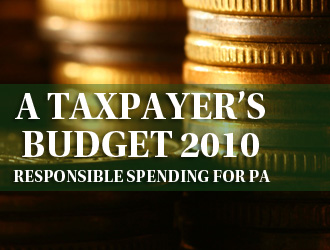Report

A Taxpayer’s Budget 2010: Responsible Spending for Pennsylvania
Executive Summary
A Taxpayer’s Budget 2010: Responsible Spending for Pennsylvania identifies opportunities to cut over $4 billion in wasteful state spending in Gov. Rendell’s proposed FY 2010-11 budget. The report also offers a series of recommendations for resolving the current revenue shortfall and reducing the size and burden of government on Pennsylvanians.
State government consumption and spending of taxpayer money have grown dramatically in recent years. Since 1970, Pennsylvania’s total operating budget has increased from $4.2 billion to $65.9 billion, an inflation-adjusted increase of over 167%.[1] As a share of state personal income, Pennsylvania’s operating budget rose from 8.8% in FY 1970-71 to an estimated 13.2% in FY 2009-10-an increase of more than 51%.[2]
The effect of this tax-borrow-and-spend agenda has not produced the promised economic revitalization, but stagnation. During Ed Rendell’s tenure as governor, Pennsylvania ranks 32nd, 41st, and 39th in job, personal income, and population growth, respectively, among the 50 states.[3]
On October 9, 2009, after an unprecedented 101-day delay, the Pennsylvania General Assembly approved, and Governor Ed Rendell signed, a $27.8 billion General Fund Budget for FY 2009-2010. A revenue shortfall has since emerged, and politicians will be scrambling to fill a multi-billion dollar budget gap with rising pension contributions and the disappearance of federal “stimulus” dollars on the horizon. Against Commonwealth Foundation recommendations, the FY 2009-10 budget exhausted the state’s “Rainy Day” fund and other one-time revenue sources. A Taxpayer’s Budget 2010 offers budgetary and public policy alternatives to deal with this fiscal crisis.
A Taxpayer’s Budget 2010 identifies wasteful and unnecessary programs in the state budget and off-budget agencies and offers recommendations for improving government services and reforming the budget process for greater efficiency. Our recommendations are organized into three sections:
- Eliminate Wasteful Spending: A Taxpayers Budget 2010 identifies $4.13 billion in spending cuts – $1.00 billion from the state General Fund Budget, $2.21 billion from other operating funds, and $926 million from the capital budget and off-budget programs.
- Adopt Market-Based Delivery of Government Services: Spending on public education, benefits for state workers, and Medicaid is growing far beyond taxpayers’ ability to pay. By adopting market-based reforms in the delivery of services, state government can not only reduce costs, but improve quality.
- Adopt Spending and Budgetary Transparency Reforms: Transparency in government spending and instituting performance-based budgeting would help identify and eliminate wasteful expenditures, as shown in other states.
Before imposing tax increases on working Pennsylvanians and job creators, Harrisburg policymakers need to prioritize spending, justify all $66 billion in state spending, and cut waste from state government.
[1] Pennsylvania Governor’s Office of the Budget, www.budget.state.pa.us.
[2] U.S. Bureau of Economic Analysis, “State Personal Income and Employment,” www.bea.gov; Pennsylvania Governor’s Office of the Budget, www.budget.state.pa.us.
[3] U.S. Bureau of Labor Statistics, “December Seasonally Adjusted State Employment,” www.bls.gov; U.S. Bureau of Economic Analysis, “State Quarterly Income Analysis,” www.bea.gov; U.S. Bureau of the Census, “Annual Population Estimates,” www.census.gov.
# # #
EDITOR’S NOTE: The full report, A Taxpayer’s Budget 2010: Responsible Spending for Pennsylvania, is available online and by calling 717.671.1901. For more on the Pennsylvania State Budget, visit www.PABudget.org.
The Commonwealth Foundation (www.CommonwealthFoundation.org) is an independent, non-profit public policy research and educational institute based in Harrisburg, PA.